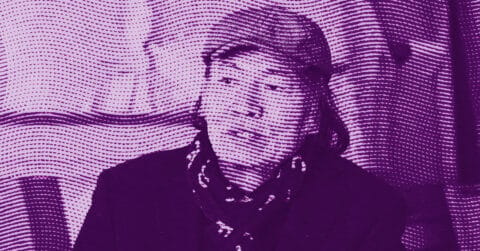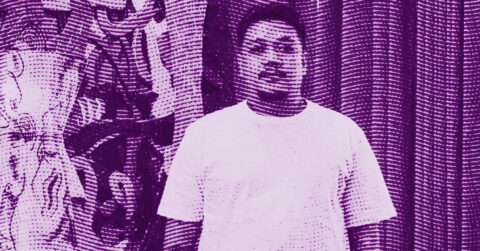Listen to me carefully, you bunch of snobs who pretend to understand contemporary Chinese art by marveling at the latest conceptual extravagances from Beijing. While you lecture on video installations and provocative performances, a man quietly reinvents the millenary art of gongbi in his Shanghai studio. Ren Zhong does not seek to impress Western critics with pop references or political deviations. No, this artist born in 1976 in Yinchuan is undertaking a far more perilous task: resurrecting the spirit of the ancient masters while infusing it with his contemporary sensitivity.
His artistic journey disrupts academic conventions. Son of an art professor from Ningxia, Ren Zhong abandoned his university studies midway to devote himself entirely to studying the masters of the Tang, Song, and Yuan dynasties. This assumed self-taught approach recalls the great names of modern Chinese painting who, from Zhang Daqian to Qi Baishi, forged their style outside institutions. But where his predecessors innovated out of historical necessity, Ren Zhong deliberately chooses the path of complete transmission.
The 2019 exhibition “Twin Wings to the Glory” held in Vancouver reveals the breadth of his ambition. Thirty-eight works unfold a pictorial universe of striking coherence, where every stroke participates in a global aesthetic vision. Curators Lam Wong and Viahsta Yuan highlighted this particularity: for Ren Zhong, the gongbi technique is not a straitjacket but a language of surgical precision serving personal expression.
The artist’s technical mastery commands admiration, but it is his ability to infuse contemporary emotion into ancestral pictorial codes that truly distinguishes him. His seasonal paintings, organized according to a natural progression from winter to spring, then summer and autumn, reveal a profound understanding of temporal cycles that goes beyond mere naturalistic illustration. Every chromatic change, every shift in ink density expresses an acute perception of impermanence.
Architecture and verticality: the contemplative space of Ren Zhong
Ren Zhong’s work fits within a particular relationship to space that immediately evokes the fundamental principles of traditional Chinese architecture. Like the master builders of temples and imperial pavilions, the artist organizes his compositions according to axes of force and points of balance that structure the viewer’s gaze. This kinship is no accident: it reveals a common conception of space as a place for meditation and contemplation.
In his depictions of solitary scholars navigating waterways lined with centuries-old pine trees, Ren Zhong reproduces the spatial codes of classical Chinese gardens. Each pictorial element functions like a pavilion or a bridge in a Suzhou garden: it guides the eye, creates moments for contemplation, and opens up infinite perspectives. This architectural approach to pictorial composition reaches its pinnacle in his large-scale works, such as this six-panel screen depicting bamboo under the snow, where the monumentality of the support interacts with the intimacy of the motif.
The artist has mastered the art of verticality, a direct legacy of the construction techniques of Chinese pagodas. His pines with twisted branches rise towards the heavens following curves that defy the laws of gravity, much like the soaring eaves of Song architecture. This verticality is never gratuitous: it expresses a spiritual aspiration that elevates the work beyond mere naturalistic representation.
The circulation of qi, a fundamental principle of feng shui architecture, also finds expression in Ren Zhong’s organization of masses and voids. His compositions breathe thanks to a skillful balance between saturated areas and free spaces, creating that sensation of harmony provided by the finest examples of traditional Chinese architecture. The artist intuitively understands that unpainted space carries as strong an emotional charge as the worked areas, thus embracing the lessons of master builders who knew how to arrange inner courtyards to enhance their structures.
This architectural approach to painting is also evident in the treatment of light. Ren Zhong modulates his inks like an architect playing with shadows and transparencies through paper partitions and wooden moucharabiehs. His subtle gradients create luminous atmospheres that evoke the muffled ambiance of Buddhist temples or the golden twilight of imperial libraries.
The temporal dimension of Chinese architecture also resonates in Ren Zhong’s work. Like those buildings designed to endure through centuries by adapting to seasonal changes, his paintings incorporate the notion of duration into their very conception. His exceptional materials, old inks, precious silks, and aged papers, contribute to this desire to create works capable of aging with nobility, like the patinas that adorn the woodwork of centuries-old temples.
This kinship with classical Chinese architecture does not prevent the artist from introducing elements of modernity. His unexpected pastel colors, like the delicate violet that surprises in certain compositions, function like contemporary elements that current architects sometimes integrate into the restoration of historic monuments: they discreetly signal the creation era while respecting the spirit of the place.
Literature and poetry: the art of the unsaid according to Ren Zhong
Ren Zhong’s relationship to classical Chinese literature goes far beyond illustration or quotation. It is rooted in a deep understanding of the poetic mechanisms that govern the art of the unsaid, the distinctly Chinese ability to suggest infinity through detail and the universal through the particular. The artist does not paint poetry; he paints poetically, an essential nuance that distinguishes him from talented illustrators.
This literary dimension is first expressed in his conception of pictorial time. Like Tang poets who knew how to condense an entire season into a seven-character verse, Ren Zhong concentrates the different moments of a natural cycle within a single composition. His plum paintings thus combine spring buds, blossomed flowers, and ripe fruits, creating a poetic temporality that abolishes linear chronology. This technique directly evokes the metaphorical condensation methods dear to the great Chinese lyricists.
The influence of Du Fu’s poetry is particularly evident in his depictions of hermits and scholars. Just as the great Tang poet knew how to evoke the sage’s solitude in the face of the tumultuous history of his time, Ren Zhong places his characters in landscapes that transcend anecdote to reach the archetype. His solitary fishermen navigating through the reeds do not tell a particular story but embody the ideal of scholarly detachment from the vanities of the world.
The art of ellipsis, so characteristic of classical Chinese poetry, finds a remarkable plastic translation in Ren Zhong’s work. His compositions allow meaningful voids that function like silences in a Li Bai poem: they do not mark an absence but a sublimated presence. These unpainted spaces carry an emotional charge comparable to the unspoken words of great poetry, creating in the viewer an inner resonance that Chinese aestheticians call yijing.
The notion of parallelism, fundamental in Chinese versification, also structures the organization of his works. Ren Zhong establishes subtle correspondences between the different registers of his compositions: a flight of birds echoes the curve of a branch, the texture of a rock dialogues with that of a cloud. These visual mirror games reproduce the effects of semantic symmetry that characterize the couplets of Tang and Song poetry.
The artist also masters the art of the poetic drop, that ability to concentrate the entire meaning of a work into a final detail. In his animal paintings, a simple bird’s gaze or the orientation of a fish’s tail can radically transform the reading of the whole, functioning like those final verses that retrospectively illuminate an entire poem.
His collaboration with musician Dou Wei for the monumental work “Rayon de géants” perfectly illustrates this literary dimension of his art. The artist does not just illustrate Tian Xi’s classical text; he offers a plastic rewriting that respects the spirit of the original text while bringing his contemporary sensitivity to it. This approach recalls the practices of great calligraphers who knew how to reinvent ancient texts through their sole graphic interpretation.
The influence of literature is also evident in his conception of the series as an artistic form. Like poetic collections organized according to thematic or temporal progressions, Ren Zhong conceives his exhibitions as coherent cycles where each work dialogues with the others to create an overall meaning. This sequential approach evokes the great Chinese poetic anthologies where the juxtaposition of texts generates meanings that each poem taken alone could not produce.
Finally, the self-reflexive dimension of his art, particularly evident in his conception of “xi mo” (晞墨), the drying of ink, reveals a deep meditation on the relationships between creation and temporality rooted in the great Chinese literary tradition. Like those poets who incorporated a reflection on the very act of writing into their verses, Ren Zhong makes creative waiting an essential component of his aesthetic, transforming the technical constraint into an opportunity for philosophical contemplation.
The millennial heritage serving a contemporary vision
The revelation of Ren Zhong’s genius lies in his ability to solve an equation that many contemporary artists deem impossible: how to remain faithful to a millennia-old tradition while expressing the sensitivity of a 21st-century man? The artist answers by example, demonstrating that innovation does not necessarily imply rupture and that modernity can arise from deepening rather than rejection.
His work on the negative ink technique, inspired by the mythical “Peinture de bambous sous la neige” by Xu Xi preserved at the Shanghai Museum, perfectly illustrates this approach. Where others would have seen an archaeological challenge, Ren Zhong identifies contemporary expressive potential. His reconstruction of this technique, lost for a thousand years, is not an exercise in scholarship but a creative necessity. The whites structuring his snow compositions function as breaths in a world saturated with images, offering the contemporary eye these contemplative pauses that our hyperconnected societies sorely need.
This discreet but effective modernity also manifests itself in his use of colors. When Ren Zhong introduces an unexpected pastel violet in a composition otherwise respectful of traditional canons, he does not commit an anachronism but subtly updates his message. This contemporary color functions as a temporal marker that anchors the work in the present without breaking its overall harmony.
The artist intuitively understands that tradition is not a museum but a living organism capable of evolution. His collaboration with contemporary fashion brands like CLOTTEE by CLOT attests to this desire to inscribe traditional art in current economic and cultural circuits. Far from trivializing his art, this approach democratizes it and ensures its transmission to new generations.
His relationship with materials also reveals this fruitful dialectic between tradition and modernity. Ren Zhong uses exclusively ancient inks and exceptional papers, but this qualitative demand responds to very contemporary concerns: durability, authenticity, resistance to planned obsolescence. In a world dominated by the ephemeral and disposable, his choice of lasting materials constitutes an act of aesthetic as much as ethical resistance.
The international dimension of his recognition, from Vancouver to London through Florence, shows that Ren Zhong’s art speaks a universal language that no longer nests Chinese understanding. His works find their audience in very different cultural contexts, proof that technical excellence and emotional sincerity constitute transcultural values.
This universality never harms the cultural specificity of his art. On the contrary, it is by fully assuming his Chineseness that Ren Zhong accesses universality. His paintings offer Western viewers an authentic entry point to Chinese aesthetic sensitivity, free from the orientalist clichés that too often clutter cultural exchanges between East and West.
His commercial success, far from compromising his artistic integrity, validates his creative approach. When his works reach sums of over one million United States dollars at auction [1], they only confirm what discerning enthusiasts already knew: Ren Zhong produces rare art that reconciles aesthetic demand and genuine emotion.
The artist thus embodies an alternative path to the conventional avant-gardism that dominates international artistic circuits. His modernity is not fueled by provocation but by depth, not seeking effect but truth. This approach, which some might judge conservative, actually reveals a discreet but unrelenting radicalism: one that still believes in art’s capacity to elevate the human soul rather than simply entertain or shock it.
In an artistic landscape often marked by cynicism and ease, Ren Zhong reminds us that art can still constitute a demanding spiritual path. His example inspires and reassures: there are still artists capable of dedicating their entire lives to the pursuit of excellence, sacrificing easy success in favor of true fulfillment.
Perhaps this is where the most precious lesson of his journey lies: authentic modernity does not arise from the negation of the past but from its creative reinvention. By breathing new life into ancient techniques, updating traditional sensibilities, and passing down millennial knowledge to future generations, Ren Zhong accomplishes the essential task that distinguishes the artist from the mere practitioner: he keeps alive the flame of beauty in a world that sometimes seems to have forgotten it.
His work strongly reminds us that true art never ages, that it carries within it an eternity allowing a brush of today to converse with the masters of yesterday and inspire the creators of tomorrow. In this unbroken chain of transmission and reinvention, Ren Zhong now occupies a place of choice, that of an authentic bridge between worlds and eras, a modern guardian of ancient treasures, a contemporary creator rooted in the eternity of art.
- Montecristo Magazine, “Ren Zhong’s Art Bathes Us in Nature”, Robin Perelle, November 2019.
















